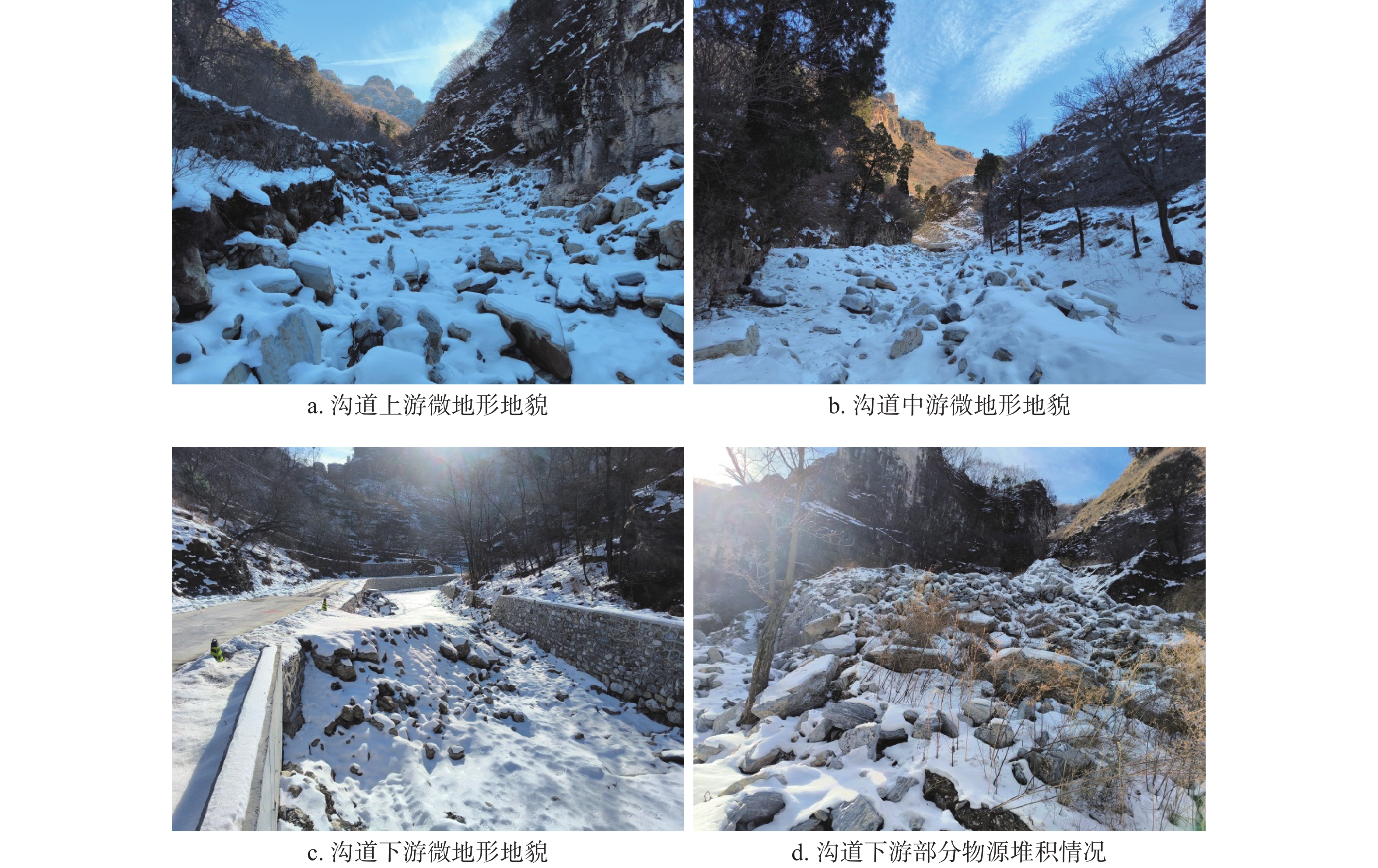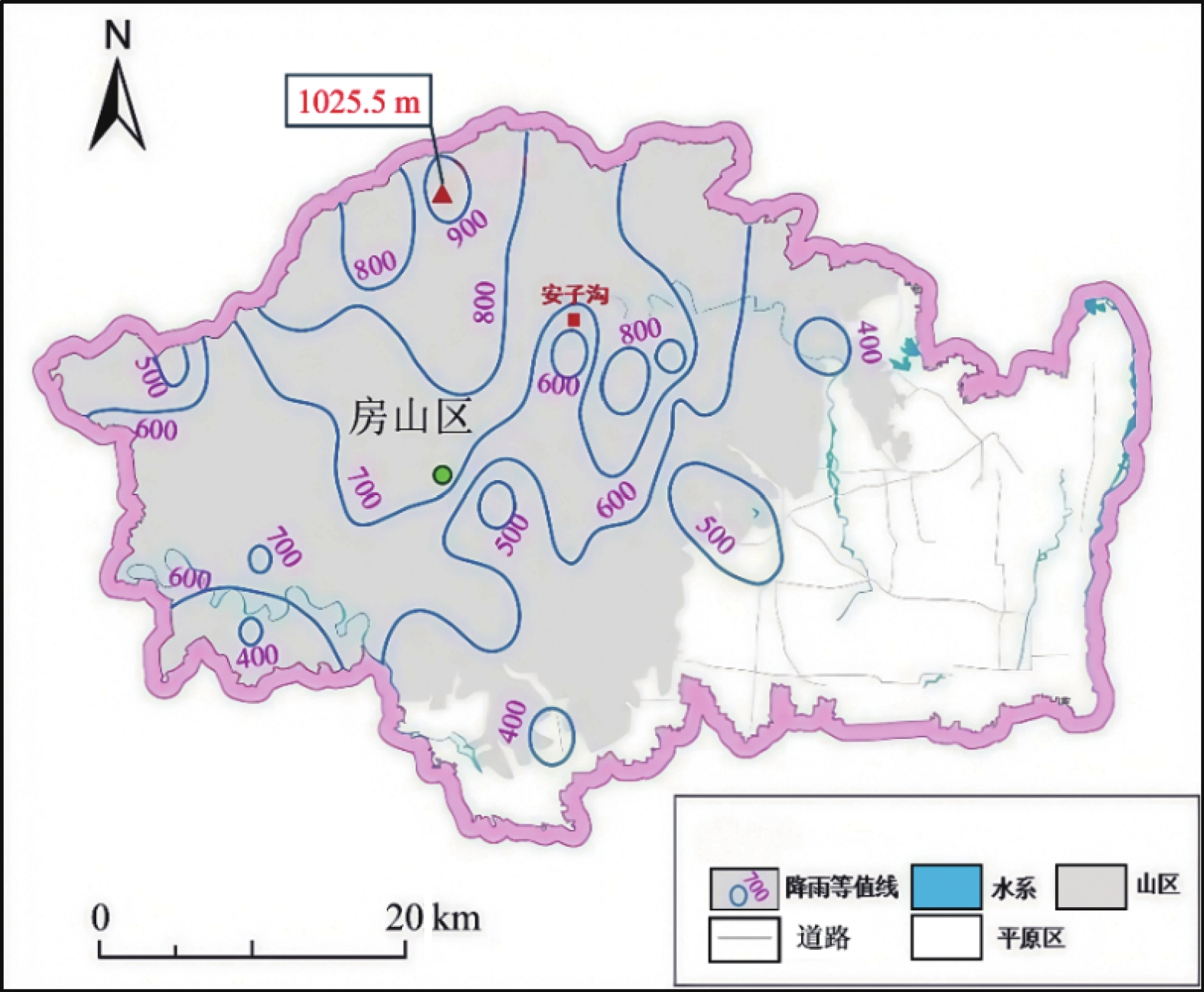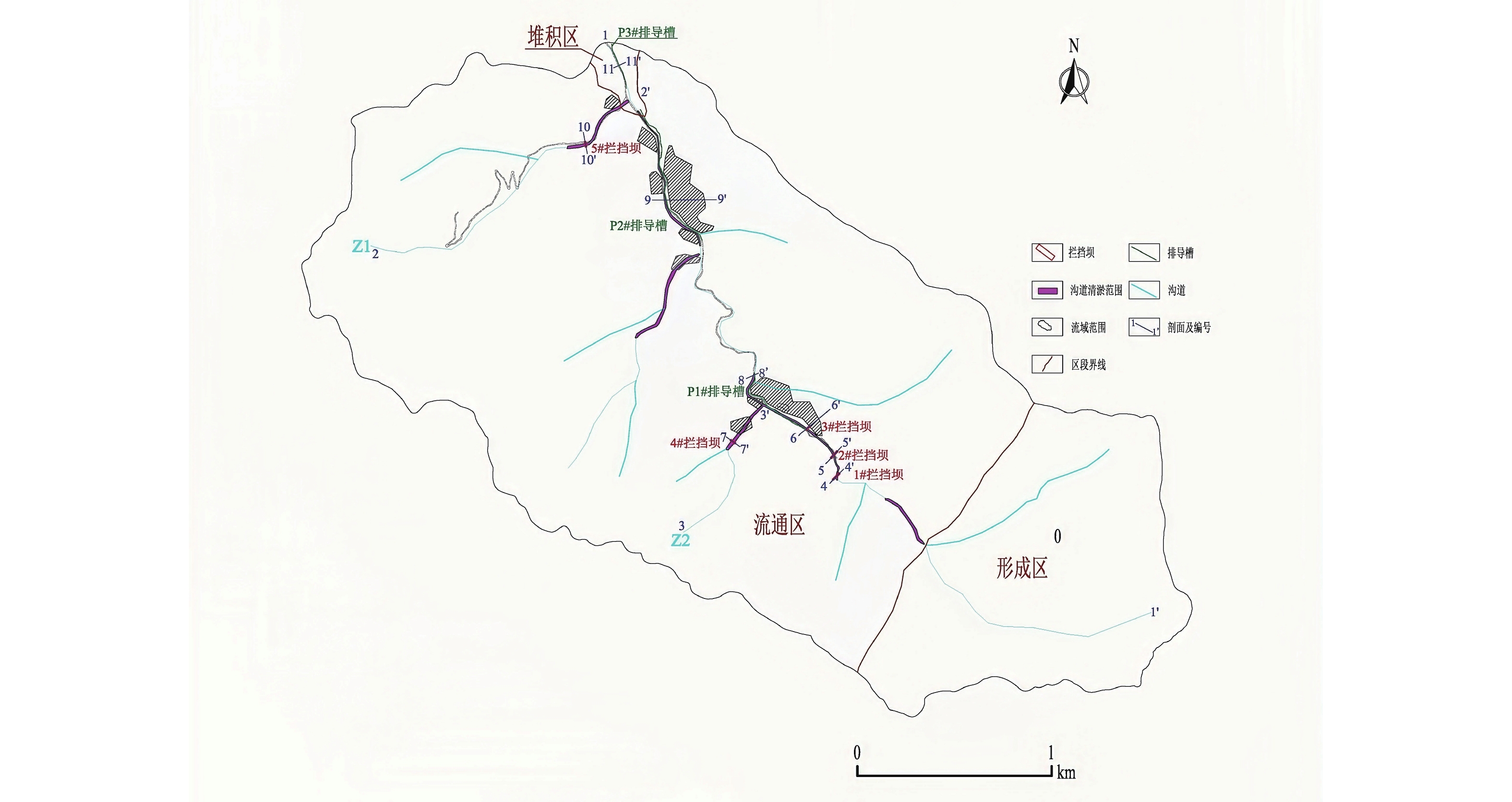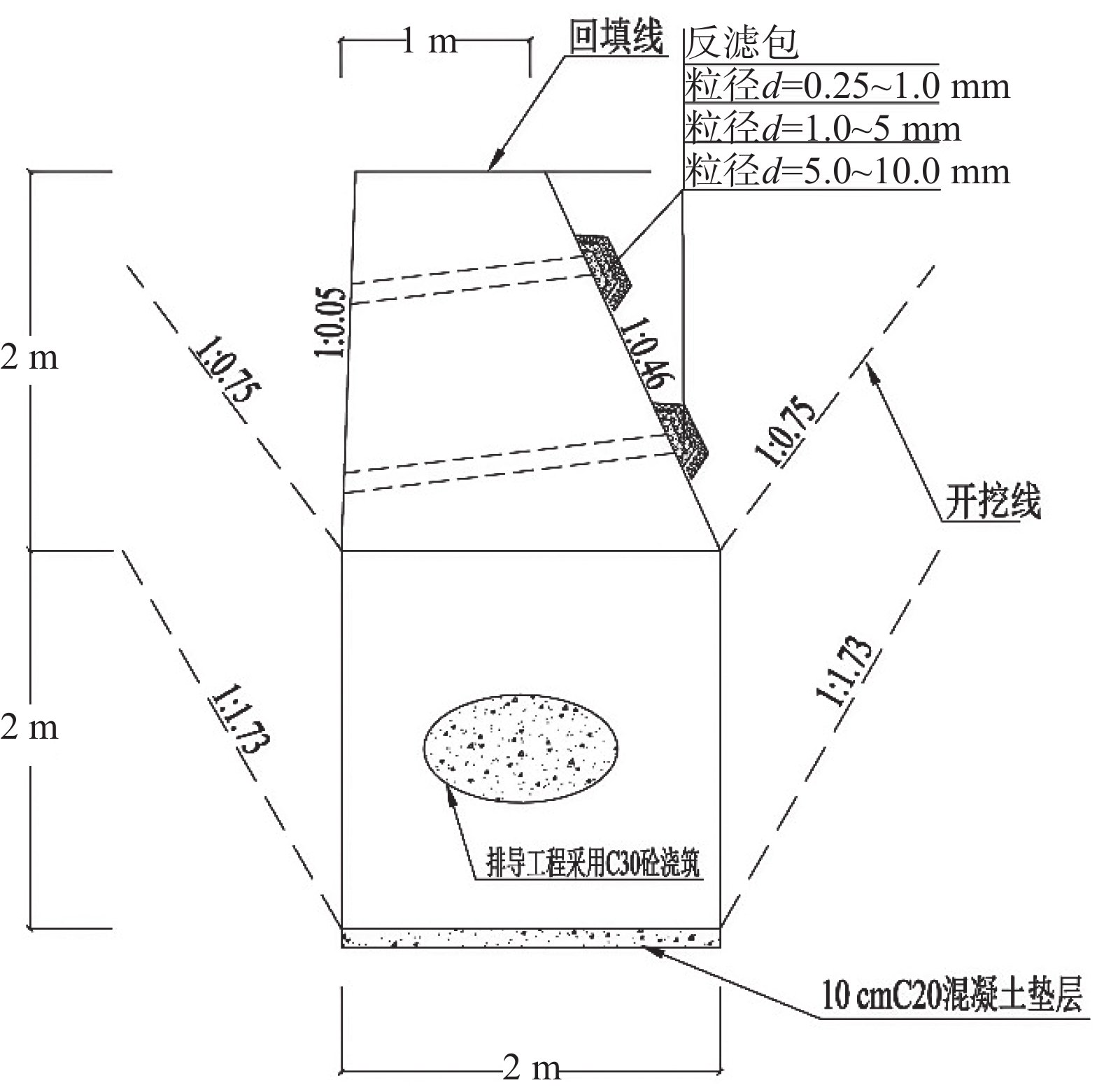Formation Mechanisms and Mitigation Engineering Design of the Anzigou Debris Flow in Sihe Village, Xiayunling Township, Fangshan District, Beijing
-
摘要:
2023年7月29日20时至8月2日7时,受第5号强台风“杜苏芮”残余环流及副热带高压影响,北京遭遇有仪器测量记录140年以来最强降雨天气,北京市房山区霞云岭乡四合村安子沟泥石流受强降雨影响严重,大量碎石冲出后堆积于沟道内,造成部分排水沟损毁,村道路基掏空,农田冲毁,威胁当地村民的生命财产安全。本文通过对安子沟泥石流现场情况进行详细调查,采用槽探、物探、岩土测试等勘查手段,确定了该泥石流的基本特征,计算了泥石流动力学参数,结合遥感影像对其形成机制、动力学特征进行了综合分析,最后对安子沟泥石流进行了综合治理。结果表明:该沟泥石流在短时强降雨情况下,大量雨水入渗坡面形成地表径流并汇于沟道内;由于土壤的含水量增大,土中孔隙水压力增加,沟道内堆积物的粘聚力和内摩擦角减小,导致坡面表层土体失稳发生崩塌、滑坡,大量松散固体物质涌入沟道;水流沿沟道掏蚀、侧蚀沟道岸坡又形成了大量松散固体物质。该泥石流松散堆积物动储量为
78294 m3,物源类型主要分为崩滑型、沟道冲刷型、坡面侵蚀型和弃渣堆积型,其中占比较大的为崩滑型物源、沟道冲刷型物源;通过计算确定了泥石流动力学的各项参数,最后采用“沟道清理+拆除破损结构+拦挡坝+排导槽”拦、排相结合的综合治理方案。Abstract:From 20:00 on July 29 to 7:00 on August 2, 2023, influenced by the residual circulation of Typhoon Doksuri (No. 5) and the subtropical high-pressure system, Beijing experienced its most intense rainfall in 140 years of instrumental records. The Anzigou debris flow in Xiayunling Township, Fangshan District, Beijing, was severely impacted by the heavy rainfall. Massive amounts of debris rushed out and accumulated in the gully, causing partial destruction of drainage ditches, hollowing out of village road foundations, farmland erosion, and posing threats to local residents' lives and property. Through detailed field investigations of the Anzigou debris flow, employing trench exploration, geophysical exploration, and geotechnical testing, this study identified the fundamental characteristics of the debris flow. Dynamic parameters were calculated, and remote sensing imagery was integrated to comprehensively analyze its formation mechanisms and dynamic characteristics. Ultimately, comprehensive mitigation measures were implemented for the Anzigou debris flow. Results indicate that due to short-duration intense rainfall, significant rainwater infiltration formed surface runoff converging in the gully. Increased soil moisture content elevated pore water pressure and reduced cohesion and internal friction angle of gully deposits, triggering slope surface instability manifesting itself as collapses and landslides that delivered substantial loose material into the channel. Subsequent channel scouring and bank erosion generated additional loose deposits. The dynamic reserves of loose material totaled
78294 m3, with material sources categorized as collapse-slide type (predominant), channel erosion type, slope erosion type, and waste accumulation type. Through parameter calculations of debris flow dynamics, an integrated mitigation strategy as “channel clearance-damaged structure removal-check dams-diversion channels” was adopted, effectively addressing both interception and drainage requirements. -

-
表 1 安子沟泥石流运动特征参数表
Table 1. Table of dynamic parameters for the Anzigou debris flow
名称 计算
断面断面流速
(m/s)峰值流量
(m3/s)一次冲出固体
物质总量(×104 m3)整体冲击力
P(kN)大块石
冲击F(kN)最大冲起
高度(m)爬高
(m)弯道超高
Δh(m)主沟 6 — 6' 1.93 186.75 2.75 8.27 14.42 0.186 0.28 0.58 Z1支沟 7 — 7' 2.03 106.26 1.57 9.15 15.16 0.206 0.33 0.50 Z2支沟 10 — 10' 2.22 25.75 0.38 10.94 16.58 0.246 0.39 070 表 2 安子沟泥石流岩土体物理力学参数表
Table 2. Table of physical and mechanical parameters of geotechnical materials for the Anzigou debris flow
地基岩土体名称 承载力特征fak(kPa) 基底摩擦系数 碎石土 250 0.4 白云岩(强风化) 500 0.65 表 3 安子沟泥石流防治工程设计的拦挡坝尺寸参数表
Table 3. Table of check dam dimensional parameters for the mitigation engineering design of the Anzigou debris flow
名称 位置 坝高(m) 有效坝高(m) 基础埋深(m) 长度(m) 坝顶宽度(m) 坝底宽度(m) 1#拦挡坝 主沟 10 7 3 50 3 8 2#拦挡坝 主沟 8 5 3 40 3 8 3#拦挡坝 主沟 8 5 3 30 3 8 4#拦挡坝 支沟1 10 7 3 30 3 8 5#拦挡坝 支沟2 8 5 3 25 3 8 表 4 安子沟泥石流防治工程设计的拦挡坝稳拦物源能力表
Table 4. Table of check dam sediment retention capacity for the mitigation engineering design of the Anzigou debris flow
工程名称 沟谷纵比降(‰) 回淤纵比降(‰) 回淤平面面积(m2) 回淤坝库区平均深度(m) 坝的回淤库容(m3) 1#拦挡坝 202.8 101.4 11000 3.5 38500 2#拦挡坝 87 43.5 1800 2.5 4500 3#拦挡坝 61.2 30.6 5600 2.5 14000 4#拦挡坝 210 105 5500 3.5 19250 5#拦挡坝 230 115 6000 2.5 15000 合计 91250 表 5 安子沟泥石流防治工程设计的泥石流拦挡坝坝体自重计算表
Table 5. Self-weight calculation table for the check dam structure in the mitigation engineering design of the Anzigou debris flow
名称 坝体容重
(kN/m3)坝体单宽
体积(m3)坝体自重
(kN)1#拦挡坝 24.00 62.5 1500 2#拦挡坝 24.00 51.5 1236 3#拦挡坝 24.00 51.5 1236 4#拦挡坝 24.00 62.5 1500 5#拦挡坝 24.00 51.5 1236 表 6 安子沟泥石流防治工程设计的拦挡坝整体冲击力计算表
Table 6. Overall impact force calculation table for the check dam in the mitigation engineering design of the Anzigou debris flow
计算部位 建筑物
形状系数γ泥石流重度
γc(kN/m3)泥石流平均
流速(m/s)受力面与泥石流
冲压力方向的夹角(°)泥石流整体
冲击力(kN)1#拦挡坝 1.33 16.69 1.93 90 8.27 2#拦挡坝 1.33 16.69 1.93 90 8.27 3#拦挡坝 1.33 16.69 1.93 90 8.27 4#拦挡坝 1.33 16.69 2.03 90 9.15 5#拦挡坝 1.33 16.69 2.22 90 10.94 表 7 安子沟泥石流大块石冲击力计算表
Table 7. Boulder impact force calculation table for the Anzigou debris flow
计算部位 动能
折减系数r泥石流平均
流速(m/s)受力面与泥石流
冲压力方向的夹角(°)大块石
质量(t)巨石、构筑物的
弹性变形系数C1+C2泥石流大块石
冲击F(kN)1#拦挡坝 0.3 1.93 90 3.1 0.005 14.42 2#拦挡坝 0.3 1.93 90 3.1 0.005 14.42 3#拦挡坝 0.3 1.93 90 3.1 0.005 14.42 4#拦挡坝 0.3 2.03 90 3.1 0.005 15.16 5#拦挡坝 0.3 2.22 90 3.1 0.005 16.58 表 8 安子沟泥石流坝体抗滑移和抗倾覆稳定性计算表
Table 8. Anti-sliding and anti-overturning stability calculation table for the dam structure of the Anzigou debris flow
名称 抗滑移稳定性系数 抗倾覆稳定性系数 满库过流 半库过流 空库过流 满库过流 半库过流 空库过流 工况Ⅰ 工况Ⅱ 工况Ⅲ 工况Ⅳ 工况Ⅴ 工况Ⅵ 工况Ⅰ 工况Ⅱ 工况Ⅲ 工况Ⅳ 工况Ⅴ 工况Ⅵ 1#拦挡坝 6.88 2.23 5.46 1.86 3.49 1.21 24.62 11.08 8.87 5.94 2.49 2.18 2#拦挡坝 6.78 2.240 5.83 1.90 3.66 1.23 25.95 11.70 9.40 6.27 2.47 2.17 3#拦挡坝 7.18 2.28 5.14 1.82 3.30 1.23 28.93 12.67 9.09 6.24 2.45 2.17 4#拦挡坝 11.71 2.60 4.17 1.74 3.08 1.25 47.01 16.26 7.86 5.86 2.51 2.25 5#拦挡坝 11.74 2.63 4.53 1.80 3.27 1.36 52.09 17.80 8.31 6.23 2.44 2.21 表 9 安子沟泥石流坝体地基应力计算表
Table 9. Foundation stress calculation table for the check dam of the Anzigou debris flow
工程名称 基底
宽度(m)最小地基
应力(kN)最大地基
应力(kN)1#拦挡坝 8 10.3 184.5 2#拦挡坝 8 10.3 184.5 3#拦挡坝 8 7.4 155.6 4#拦挡坝 8 9.1 168.2 5#拦挡坝 8 8.2 159.1 -
[1] 北京市地质工程勘察院有限责任公司. 2024. 房山区霞云岭乡四合村安子沟泥石流灾害隐患勘查报告[R].
[2] 北京市水文总站,北京市水利规划设计研究院. 1999. 北京市水文手册第一分册暴雨图集[Z]. 北京:北京市水利局.
[3] 陈家华.1994.北京北山地区泥石流灾害特点及其防治现状研究[J]. 中国地质灾害与防治学报,5(S1):36-44.
[4] 冯 驰.2019.北京碰河寺沟泥石流成因及综合防治对策[J]. 矿产勘查,10(11):2728-2733.
[5] 何 媛,袁爱萍,胡 影,夏照华.2013.北京泥石流沟道现状调查及特征分析[J]. 中国水利,(21):49-51.
[6] 黄玉华.2014.陕北延安地区2013年“7.3”暴雨特征及地质灾害成灾模式浅析[J]. 灾害学,29(2):54-59.
[7] 李金海. 2007. 北京山洪泥石流[M]. 北京:中国林业出版社.
[8] 李晓玮.2020.不同工况条件对均质土体稳定性的影响[J]. 城市地质,15(4):371-379.
[9] 李晓玮,郭 英,郑晓钰.2024.北京市门头沟区“23·7”强降雨引发地质灾害特征及防治建议[J]. 城市地质,19(3):291-298.
[10] 罗守敬.2023.北京市房山区突发地质灾害发生规律、成因分析及防治对策[J]. 城市地质,18(4):1-7.
[11] 马传浩,陈 剑.2019.地质雷达技术在泥石流灾害调查中的应用—以北京房山南安主沟泥石流为例[J]. 地质与勘探,55(4):1066-1072.
[12] 马俊学,高会然,许 冲.2024.北京市昌平区韩台村“23·7”暴雨山洪泥石流灾害特征分析[J]. 水利水电技术(中英文),55(7):1-18.
[13] 南 赟,翟淑花,李 岩,曹 颖,罗守敬,王云涛,郭学飞.2024.北京地区“23·7”特大暴雨型地质灾害特征及预警成效分析[J]. 中国地质灾害与防治学报,35(2):66-73.
[14] 齐 干,张长敏.2011.达摩沟泥石流形成的物质条件分析及防治对策[J]. 水文地质工程地质,38(5):102-109.
[15] 冉淑红.2013.北京市门头沟区地质灾害隐患特征[J]. 城市地质,8(3):30-34.
[16] 申 健,李瑜瑶,李巧刚.2018.北京房山地区泥石流特征分析[J]. 城市地质,13(1):59-63.
[17] 申 健,刘晓晓,李巧刚,郭 英.2017.北京房山典型泥石流物源特征及防治建议[J]. 城市地质,12(3):46-49.
[18] 孙长明,马润勇,尚合欣,谢文波,李 焱,刘 义,王 彪,王思源.2020.基于滑坡分类的西宁市滑坡易发性评价[J]. 水文地质工程地质,47(3):173-181.
[19] 孙永彬,王 诜,高丽辉,王瑞军,王 凤,董双发,汪 冰,张 恩,李存金.2021.北京延庆地区南湾道豁子沟泥石流发育特征[J]. 现代地质,35(3):753-762.
[20] 王海芝.2009.北京景区泥石流灾害灾情评估模型的建立与应用[J]. 城市地质,4(4):31-33.
[21] 王海芝,曾庆利,许 冰,胡福根,于 淼.2022.北京“7·21”特大暴雨诱发的地质灾害类型及其特征分析[J]. 中国地质灾害与防治学报,33(2):125-132.
[22] 王珊珊,罗守敬.2015.门头沟山区泥石流发育特征与岩石类型的相关性分析[J]. 城市地质,10(S1):156-160.
[23] 王 文,马 超,张 志,张 岩,路 璐.2022.北京云蒙山片区“7·16”群发性暴雨泥石流特征研究[J]. 山地学报,40(4):626-636.
[24] 王 毅,唐 川,何 楚,龚凌枫.2018.基于降雨频率的泥石流危险性评价研究[J]. 长江科学院院报,35(1):67-72.
[25] 韦京莲,董桂芝,赵 波.1994.北京山区近代泥石流活动规律及爆发周期分析[J]. 中国地质灾害与防治学报,5(4):48-53.
[26] 吴正华.2001.北京泥石流灾害及其降水触发条件[J]. 水土保持研究,8(1):67-72.
[27] 向炳霖,铁永波,李 果,张宪政.2024.川西红层地区泥石流特征研究—以德昌县群英村王家坡沟为例[J]. 华南地质,40(1):143-151.
[28] 张佳佳,刘建康,高 波,陈 龙,李元灵,邹任州,黄 亮.2018.藏东南嘎龙曲冰川泥石流的物源特征及其对扎墨公路的影响[J]. 地质力学学报,24(1):106-115.
[29] 赵松江,赵 峥,袁 广.2021.九寨沟震区泥石流物源特征研究[J]. 四川地质学报,41(1):93-97.
[30] 赵忠海.2009.北京地区泥石流灾害的发育特征及预报方法探讨[J]. 资源调查与环境,30(1):47-54.
[31] 钟敦伦,谢 洪,王士革,韦方强,靳怀成,刘世建,汤家法,杨进怀. 2004. 北京山区泥石流[M]. 北京:商务印书馆.
[32] 中国地质灾害防治工程行业协会. 2018a. 泥石流灾害防治工程勘查规范(试行)T/CAGHP006-2018[S]. 武汉:中国地质大学出版社.
[33] 中国地质灾害防治工程行业协会. 2018b. 泥石流防治工程设计规范(试行)TCAGHP021-2018[S]. 武汉:中国地质大学出版社.
[34] 祝恩珍,韩 帅,孙 萍,王 刚.2019.甘肃天水地区渭河南岸大砂沟泥石流发育特征[J]. 现代地质,33(1):227-234.
-



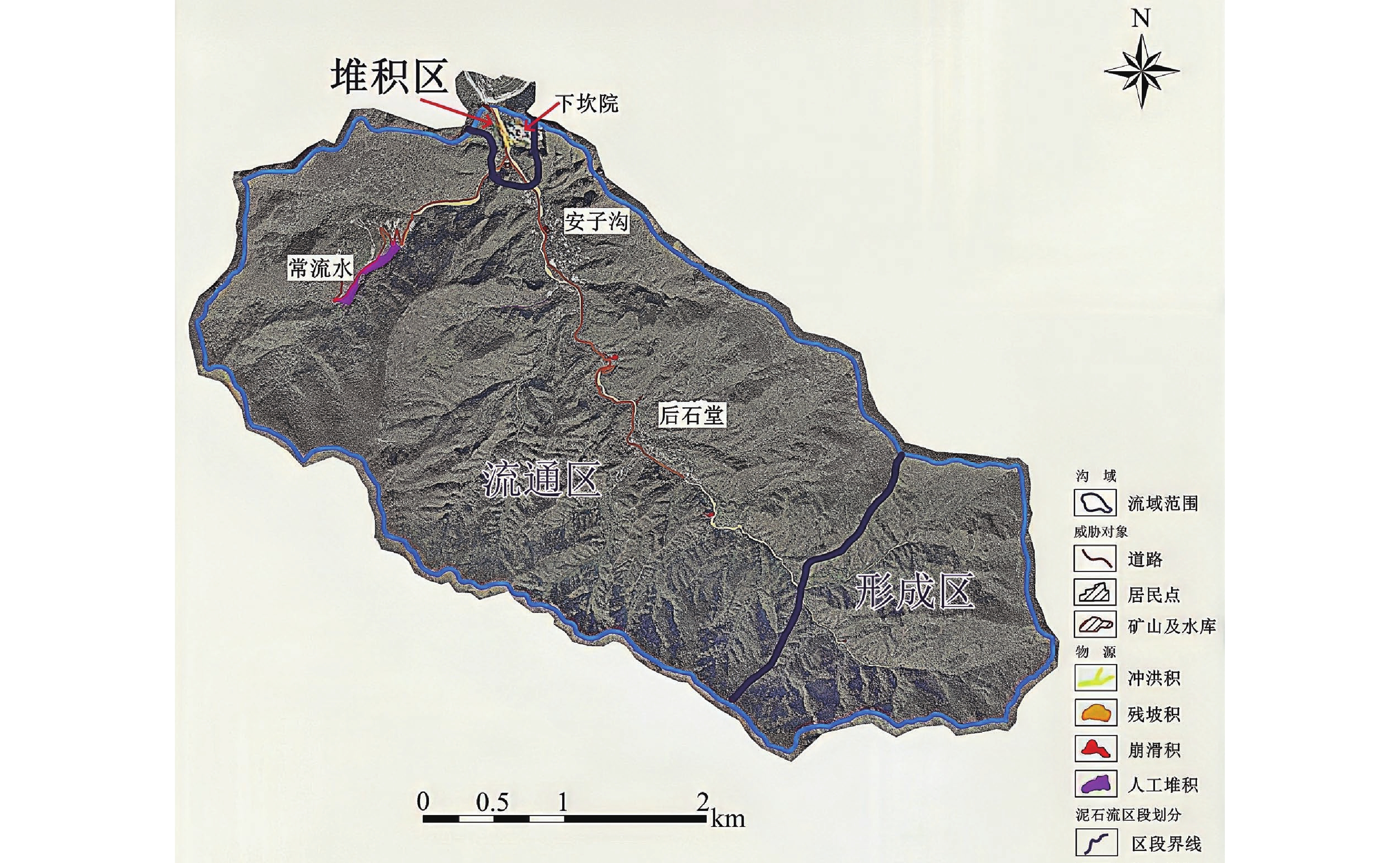
 下载:
下载:
